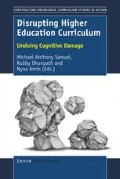Abstract
Throughout the 20th century the critical capacity of the university migrates into three surrounding institutions – technocracies, commercial sites of innovation and civil society. Technocracies, 1 which apply expertise to the management of society, replace the university’s knowledge-management function. They establish and test norms while building critical consensus through their jurisdictions and hence become the sources of today’s reliable knowledge.
Access this chapter
Tax calculation will be finalised at checkout
Purchases are for personal use only
Preview
Unable to display preview. Download preview PDF.
References
Alpers, S. (1984). The art of describing. Dutch art in the seventeenth century. Chicago, IL: Chicago University Press.
Baldwin, R. G. (1996). Faculty career stages and implications for professional development. In D. Finnegan, D. Webster, & Z. F. Gamson (Eds.), Faculty and faculty issues in colleges and universities (2nd ed.). Boston, MA: Pearson Custom Publishing.
Brown, J. (1986). Velázquez: Painter and courtier. New Haven, CT: Yale University Press.
Burckhardt, J. (2012). The civilization of the Renaissance in Italy. Mineola, NY: Dover Publications.
Cervantes, M. de. (2005). Don Quixote (E. Grossman, Trans.). New York, NY: HarperCollins Publishers.
De Mille, C. (2011). Music and modernism, c.1849–1950. Newcastle upon Tyne: Cambridge Scholars Publishing.
Douglas, M. (1986). How institutions think. Syracuse, NY: Syracuse University Press.
Eisenstein, E. (1979). The printing press as an agent of change. Cambridge: Cambridge University Press.
Elster, J. (1983). Explaining technical change: A case study in the philosophy of science. Cambridge: Cambridge University Press.
Esposito, R. (2008). Bios. Minneapolis, MN: University of Minnesota Press.
Foucault, M. (1988). Madness and civilization. A history of insanity in the age of reason. New York, NY: Vintage Books.
Foucault, M. (1994). The birth of the clinic: An archaeology of medical perception. New York, NY: Vintage Books.
Foucault, M. (1994). The order of things: An archaeology of the human sciences. New York, NY: Vintage Books.
Goethe, J. W. (2001). Faust. A tragedy (W. Arndt, Trans.). New York, NY: Norton and Company.
Hegel, G. W. F. (1983). Hegel and the human spirit (L. Rauch, Trans.). Detroit, MI: Wayne State University.
Hegel, G. W. F. (1991). Elements of the philosophy of right (H. B. Nisbet, Trans.). Cambridge: Cambridge University Press.
Julien, P. (1995). Jacques Lacan’s return to Freud: The real, the symbolic, and the imaginary (D. B. Simiu, Trans.). New York, NY: New York University Press.
Kandinsky, W. (2013). Point and line to plane. Eastford, CT: Martino Fine Books.
Klee, P. (2013). The notebooks of Paul Klee, Vol.1. The thinking eye. San Fransciso, CA: Wittenborn Art Books.
Latour, B. (1986). Visualisation and cognition: Drawing things together. In H. Kuklick (Ed.), Knowledge and society. Studies in the sociology of culture past and present (Vol. 6, pp. 1–40). Greenwich, CT: Jai Press.
Lees, H. (2007). Mallarmé and Wagner: Music and poetic language. Hampshire: Ashgate Publishing.
Greenberg, C. (2015). Avantgarde and Kitsch. Retrieved March 20, 2016, from http://sites.uci.edu/form/files/2015/01/Greenberg-Clement-Avant-Garde-and-Kitsch-copy.pdf
Harman, G. (2014). Bruno Latour: Reassembling the political. London: Pluto Press.
Kant, I. (2002a). Critique of pure reason (W. S. Pluhar, Trans.). Cambridge, MA: Hackett Publishing Company.
Kant, I. (2002b). Critique of practical reason (W. S. Pluhar, Trans.). Cambridge, MA: Hackett Publishing Company.
Kant, I. (2002c). Critique of judgment (W. S. Pluhar, Trans.). Cambridge, MA: Hackett Publishing Company.
Kittler, F. A. (1992). Discourse networks, 1800/1900. Stanford, CA: Stanford University Press.
Kittler, F. A. (1999). Gramophone, film, typewriter. Stanford, CA: Stanford University Press.
Leibniz, G. W. (1976). Philosophical papers and letters, selection translated and edited with an introduction by Leroy E. Loemker, 2nd ed. Dordrecht, Holland; Boston: D. Reidel Publishing Company.
Linnaeus, C. (Carl von Linné). (2015). Systema naturae. Rochester, NY: Scholar’s Choice.
Linnaeus, C. (2003). Philosophia botanica (S. Freer, Trans.). Oxford: Oxford University Press.
Marx, K. (1998). The German ideology. Amherst, NY: Prometheus Books.
Norman, J. (2016). Foundation of the University of Bologna. Retrieved April 2, 2016, from http://www.historyofinformation.com/expanded.php?id=3070
Nietzsche, F. (1980). On the advantage and disadvantage of history for life (P. Preuss, Trans.). Cambridge, MA: Hackett Publishing Company.
Priest, D. M. (2008). Editing the past: How Eisenstein and Vertov used montage to create Soviet history (Unpublished M.A. Thesis). State University of New York, New York, NY. Retrieved March 22, 2016, from http://digitalcommons.brockport.edu/cgi/viewcontent.cgi?article=1011&context=hst_theses
Schreber, D. P. (2000). Memoirs of my mental illness. New York, NY: NYRB Classics.
Vasari, G. (2008). The lives of the artists (J. C. Bondanella, Trans.). Oxford: Oxford University Press.
Wozniak, R. H. (1995). Mind, brain, and the experimental psychology of consciousness. In R. H. Wozniak (Ed.), Mind and body: Rene Déscartes to William James. Bethesda, MD: National Library of Medicine and American Psychological Association. Retrieved April 3, 2016, from https://serendip.brynmawr.edu/Mind/Consciousness.html
Author information
Authors and Affiliations
Editor information
Editors and Affiliations
Rights and permissions
Copyright information
© 2016 Sense Publishers
About this chapter
Cite this chapter
Devroop, C. (2016). ‘Sensing’ the Curriculum. In: Samuel, M.A., Dhunpath, R., Amin, N. (eds) Disrupting Higher Education Curriculum. Constructing Knowledge: Curriculum Studies in Action. SensePublishers, Rotterdam. https://doi.org/10.1007/978-94-6300-896-9_3
Download citation
DOI: https://doi.org/10.1007/978-94-6300-896-9_3
Publisher Name: SensePublishers, Rotterdam
Online ISBN: 978-94-6300-896-9
eBook Packages: EducationEducation (R0)

